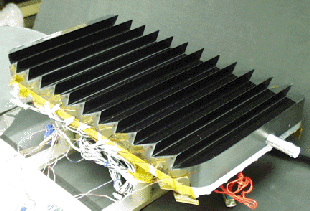Technology Focus
Principal areas of effort
- Cryogenic and Miniaturized Capillary Pumped Loops (CPLs) and Loop Heat Pipes
- Variable emittance and other advanced coatings
- Spray Cooling
Other efforts
- Sunshades (James Webb Space Telescope)
- Passive coolers, high conductivity materials, , analytical models
- Room temperature phase change devices
- Cu/H2O commercial-grade heat pipes
- Electronics cooling
Other Technologies
Variable emissivity surfaces
- For information on Variable emittance coatings, visit our page.
- Three technologies; electrochromic, electrophoretic, and MEMS-based mini-louvers
- Changes effective emissivity (ideally 0.2 to 0.8) in response to a
temperature
change or signal
- replaces VCHP array or mechanical louvers
- major savings on power (up to 90%) and/or mass
- Flown on ST5 Nanosat Constellation Trailblazer (4/06)
Advanced Conductive Heat Transfer
-
- member of C-C Spacecraft Radiator Partnership
- EO-1 radiator application (flown 11/2000)
- Thermal straps
Electrohydrodynamic Pump (EHD)
An electrohydrodynamic pump moves a fluid by applying a voltage. This works for dielectric fluids. The Thermal Engineering Branch is looking at this technology because it pumps a fluid without using any moving mechanical parts.
Fire Box
thermally stabilized paramedic drug box for fire trucks.
Spray Cooling
- High Heat Flux thermal management technique
- Laser Risk Reduction Program (LRRP) laser diode array cooling effort
- Temperature stability to +/- 1 degree C
- Weight reductions vs. traditional systems
Phase Change Thermal Storage
Putting ice cubes in a cold drink is an everyday example of using phase change for thermal control. It takes about 80 times as much heat to melt a piece of ice as it does to raise the temperature of the resulting water by 1 degree Celsius.
What's true of water is true of materials in general; it takes more heat to melt them than to raise the temperature of the liquid by several degrees. Phase change thermal storage uses this property. The Apollo Lunar Rovers incorporated phase change devices that used paraffin wax. While the astronauts were driving, heat from the equipment melted the wax. Between drives, the wax cooled and solidified. By absorbing the excess heat, the wax prevented the rover's systems from overheating.
Here is a list of some projects by the Thermal Engineering Branch that explored the uses of phase change thermal storage.
- PCM (hexadecane) in 5 honeycomb panels
- absorbs peak heat from 4 lasers
- Isothermal Blackbody Targets (room temp)
- MODIS ground demo calibration target; +/- 0.1 C
Contamination Control and Environmental Monitoring
Before the Contamination Control Engineering Branch was spun off as a separate organization, contamination control was part of the job of Code 545. Here are some of the projects we carried out before the split.
- Environmental Verification Experiment for the Explorer Platform (EVEEP) was an on-orbit experiment to study contamination levels. It flew as a secondary payload with the Extreme UltraViolet Explorer (EUVE). Mission dates: (6/1992-7/1994);
- Environmental Monitoring Package Measured the degradation of Teflon, polyurethane, Kapton, and carbon during intense exposure to atomic oxygen on the Evaluation of Oxygen Interactions with Materials Experiment (EOIM-III). It flew in 1992 on Space Shuttle Mission STS-46.
- Return Flux Experiment (REFLEX) Measured the velocity, composition, and density of the ambient environment and the return flux from an onboard noble gas source. It flew in 1996 on Space Shuttle Mission STS-72.
- CEP 1 Measured the Space Shuttle payload bay ambient molecular environment and the ambient pressure during the Hubble Space Telescope's second servicing mission in 1997 on Shuttle Mission STS-82. Date: 2/1997
- CEP 2 Measured the Space Shuttle payload ambient molecular environment and the ambient pressure in 1999 during the Hubble Space Telescope's third servicing mission, STS-103.
Multiple Technologies
Some of our tests combined two or more technologies in the same apparatus, just as you would find in an ordinary space mission.
- Space Heat Pipe/Cryogenic Two-Phase Flight Experiment (CRYOTP) Test of advanced cryogenic thermal control technology - nitrogen-charged heat pipe and phase change device for thermal storage. Flew in 1994 on Space Shuttle Mission STS-62.
- Cryogenic Flexible Diode Flight Experiment (CRYOFD) flew on two shuttle missions, STS-83 (Dates: 4/1997) and STS-92 (Dates: 7/1997).
- Cryogenic Thermal Storage Unit (CRYOTSU). This was a cooperative effort
with
Phillips Laboratory. It consisted of four tests articles:
- 60K cryogenic phase change device
- cryogenic capillary pumped loop
- cryogenic thermal switch
- room temperature phase change device
Summary
- Capillary Pumped Loops (CPLs) now operating successfully in-orbit
- Expanding role for CPLs/LHPs on flight programs; significant
operational
rewards
- each has its own set of benefits and issues
- The next major technology thrusts include
- high conductivity materials (GoCOMET)
- variable emissivity surfaces
- cryogenic or miniaturized CPL/LHP

